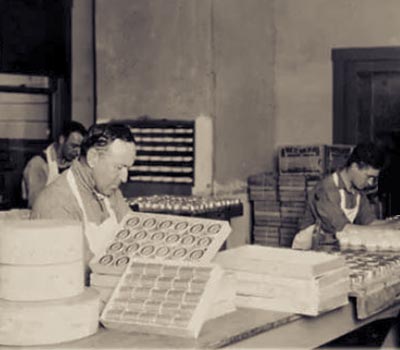With immigration such a hot-button issue, it’s worth pondering what the American cheese industry would look like if “secure the borders” had been the policy in the past. Immigrants were this country’s first cheesemakers— British, Dutch and Germans in the East and Midwest; Italians, Swiss Italians and Portuguese in Northern California. These European transplants didn’t just make our cheese; they were the customers, too, especially for smelly cheeses like Marin French Schloss.
Thompson Brothers Creamery—later renamed Marin French—debuted 150 years ago in Petaluma, California, and grew along with San Francisco. Initially, the family raised dairy cows and sold fluid milk. But they soon turned to cheese, according to company lore, because of an egg shortage in San Francisco. The hungry dockworkers needed protein for breakfast, so emissaries from the city called on Petaluma’s dairy farmers and encouraged them to produce some fresh cheese for the growing metropolis.
Marin French breakfast cheese (now called Petite Breakfast) dates from those days. Schloss came later, in 1901, aimed at European immigrants who were missing the stinky washed-rind cheeses from the old country, like German Limburger. Even today, this pungent cow’s milk cheese seems to resonate most with people who grew up with it.
“It has its cult following of people who have been eating it since they were kids,” says Liza Kaplansky, a sales manager for Marin French. “People drive to the [Marin French] store just to get the Schloss.”
Made with milk delivered daily from farms within 15 miles of the creamery, Schloss is not quite the same cheese it was a century ago, or even a decade ago. The company revisited the recipe recently, following its acquisition by a French firm (the same firm that now owns Laura Chenel’s Chevre).
Formerly a six-ounce square, it’s now an eight-ounce round, like a Camembert. Apparently a round format is easier to wash than a square. “The corners were hard to get consistent,” says Kaplansky. (We won’t bring up Taleggio or Pont l’Evêque.) More significant, I think, is that Schloss is now a triple-cream cheese, fattened up from a single-cream style.
In fact, Marin French Schloss and its popular Triple Crème Brie are identical twins separated shortly after birth. The Schloss goes into a separate aging cellar, where it is brine-rubbed repeatedly and matured for a couple of weeks. Then it’s wrapped and released at about 30 days.
“Seventy days is probably when it’s perfectly ripe, but it depends how strong you want it,” says Kaplansky. Note the “best by” date on the package and count back 100 days. That’s the make date.
I have experienced some inconsistency with Schloss, but when it’s on track and ripe, it’s yummy. The crusty, tacky, salmon-colored rind hosts a dance party of molds and bacteria. Inside, you’ll find appetizing aromas of roasted peanuts, barnyard, compost and leaf litter. The interior should be silky and spreadable, a pleasing contrast to the crunchy rind. Slice some dark bread and sweet onion and open a German hefeweizen or a saison. Now there’s a lunch.
Look for Marin French Schloss at these retail locations.
San Francisco
Bi-Rite Market, Cheese Plus, Cowgirl Creamery, Falletti Foods, Fatted Calf, Good Earth Natural Foods, Mollie Stone’s, Rainbow Grocery, Real Foods Polk Street
East Bay and Sacramento
Berkeley Bowl, Cheese Therapy, Corti Brothers, Davis Food Co-op, Nugget Market, Pasta Shop Oakland
North Bay
Oakville Grocery, Oliver’s Market, Pacific Market, Petaluma Market, Sonoma Market
South Bay
New Leaf Community Market, Sigona’s, Zanotti’s
Los Angeles
Cheese Store of Silverlake, Larchmont Village Wine & Cheese, Simons Market


